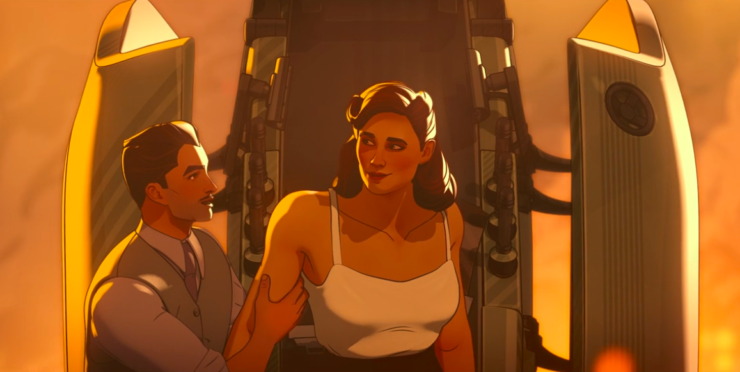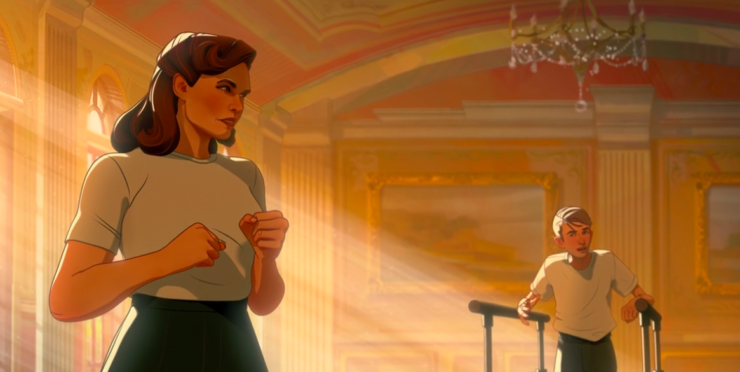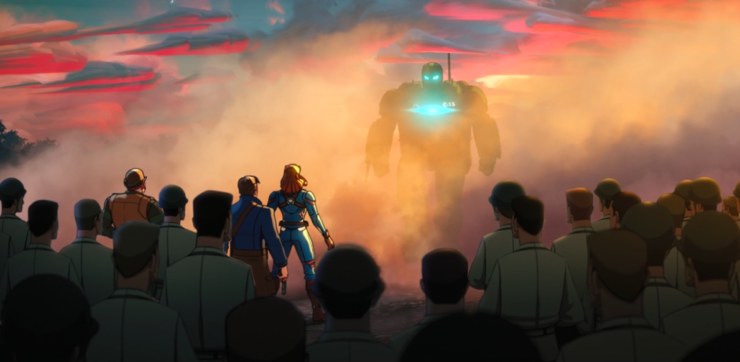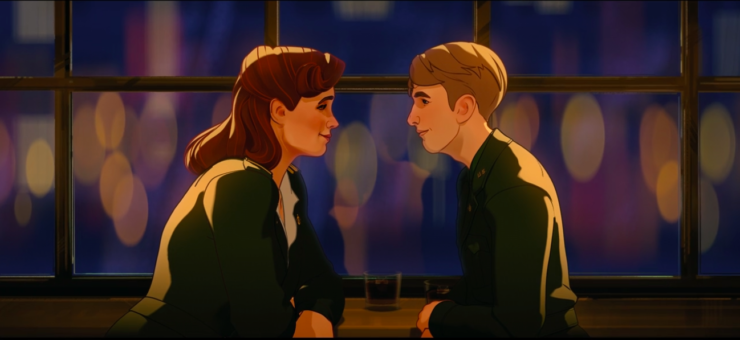Welcome to Close Reads! In this new series, Leah Schnelbach and guest authors will dig into the tiny, weird moments of pop culture—from books to theme songs to a single television episode—that have burrowed into our minds, found rent-stabilized apartments, started community gardens, and refused to be forced out by corporate interests.
Is it just me, or did Marvel’s What If…? queer the heck out of the relationship between Peggy Carter and Steve Rogers?
Now, I’m far from the first trans guy to feel a kinship to Steve and the idea of convincing a scientist to put you in a machine that will spit you out as the idealized version of the man you were supposed to be. But it is a narrative that has meant a lot to me though my own transition, and I’ve often used it as a sort of personal metaphor to guide myself through difficult moments. And if I’m being completely honest, I didn’t really want to watch “What If… Captain Carter Were The First Avenger?” Not because the concept of Peggy Carter as a super soldier isn’t totally awesome—it very much is—but because I’d created so much personal allegory from Steve’s transformation that I felt a little possessive of it. I didn’t want a story that gave that transformation to someone else, because it felt a bit too much like “What If… Someone Took Sylas’ Transition Away From Him?”
So you can imagine my surprise, not to mention joy, when I still found trans experience in both Steve and Peggy.
When Peggy steps out of Erskine’s machine, she’s gotten taller and much buffer, just as Steve did on the other timeline. Broad shouldered and muscular, she towers over Howard and basically any other man she stands beside. Howard’s first words to her are “You won’t be needing those heels anymore.” Peggy wasn’t exactly short for a woman before—she wasn’t wearing heels to be taller, she was wearing them because they are part of the required uniform, just like the army-issue skirt. Now however, Howard’s comment reminds us that she might very well feel like she can’t wear heels anymore, even when she wants to. Even in our time, muscular women, women with broad shoulders or big hands or strong necks, are often viewed as being unfeminine. Tall women find themselves feeling self-conscious about being bigger than their boyfriends and husbands, and even facing backlash from men who feel emasculated by having a female partner who is taller or—horror of horrors—stronger than them. For trans women this struggle is amplified, and it would have been for Peggy as well, back in 1942, when the requirements of femininity were even more exacting.

It goes without saying how not okay it is for men to take their personal insecurities out on their female partners. But that fear of emasculation does come from somewhere very real. The standards for manliness are also incredibly exacting—I mean, just wearing the wrong color can have your man card taken away, nevermind such sins as being short or, heaven forbid, physically weak. All small guys go through the experience of being viewed as less manly, even being infantilized—regarded more as boys than adult men. And for trans men that journey is particularly fraught, since the label is something we are forced to earn, rather than having it assigned at birth.
But Peggy doesn’t see Steve this way. Yes, in his movie she’s interested in touching those brand new Erskine-given abs. But it’s clear in every pre-serum scene they share together that Peggy sees strength, courage, and masculinity in Steve Rogers. She admires and is attracted to him as he is, without any physical transformation. What If…? takes that fact and spends more time with it, giving her the opportunity to tell him just that when he admits that he’s a little envious of the way her transformation has gained her opportunities and respect, bemoaning the fact that he is “still just that skinny kid from Brooklyn” inside a big metal suit.
“You’re more than the suit,” she tells him. “The suit is nothing without the man inside it. You’re my hero, Steve.”
And sure, Peggy is talking about the Hydra Stomper. But the message applies equally to Steve’s body. He is more than the physical form he occupies, and his worth, his manliness, come from inside, not outside. Steve’s film is technically saying this as well, but What If…? is arguably more effective with the message, because this version of Steve doesn’t get to have both. He has to live with the outside he was born with, and let the inside stand completely on its own.
But that’s Steve’s journey, and he never holds Peggy’s opportunities against her. For all that he bitterly remarks that “Women aren’t exactly lining up to dance with a guy they might step on,” in the cab ride to Project Rebirth, What If…? never suggests that he wishes that she were different, never shows him being threatened by her strength, or her build, or her status as a super soldier and hero. He only loves her more for it.

Both these characters are written as cis and straight. But their relationship defies the rules of compulsive heterosexuality in very real and poignant ways.
The woman is tall and strong, and the narrative allows her to take a place that is fully center stage in an arena that is “supposed” to belong to men. She’s not just allowed to fight, she’s shown delighting in battle and violence, delighting in her strength. And she is shown as desirable, not despite that strength, but because of it.
And the man is short, and skinny. He’s physically vulnerable, and needs armor to protect him from what Peggy can face bare-skinned. And he’s emotionally vulnerable too, sharing his fears and disappointments with her, and grieving her loss when she makes the ultimate sacrifice for the world. By upending the narrative of Steve and Peggy’s story, What If…? has taken a pretty standard wartime love story and made it just a little bit queer.
Whether these characters are literally a part of the LGBT+ community or not, they have stepped away from the norms that are prescribed for their sexuality and genders. And it gives me joy to relate to them that way, just as it gives me joy to share small-guy woes with my cis male friend who is shorter than I am, or to see my trans feminine friends delight in the careers of actresses like Gwendoline Christie and Leslie Jones. Of course I dream of a world where the narrow definitions of people don’t exist. But in the meantime, I’m happy to remember that you don’t have to be trans to have a queer love story.

Sylas K. Barrett is a writer, reader, and sometimes actor, living out his own queer love story, in Brooklyn, with his very own hero. And also their sidekick Bucky Archer.










